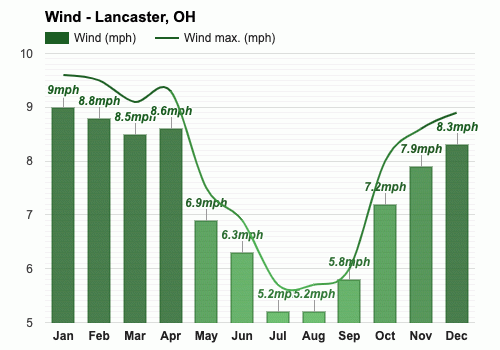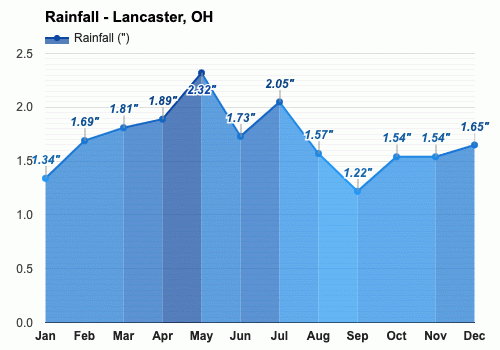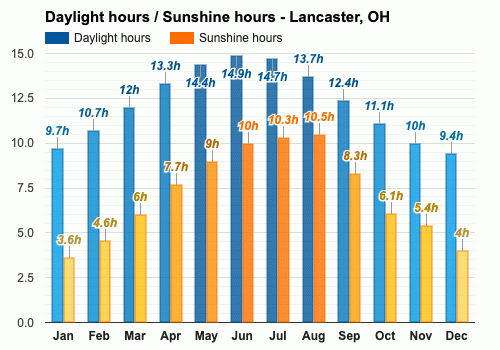Contents
- The climate of Lancaster
- The best time to visit Lancaster
- The worst time to visit Lancaster
- Spring weather in Lancaster
- Summer weather in Lancaster
- Autumn weather in Lancaster
- Winter weather in Lancaster
- Weather in January
- Weather in February
- Weather in March
- Weather in April
- Weather in May
- Weather in June
- Weather in July
- Weather in August
- Weather in September
- Weather in October
- Weather in November
- Weather in December
- Frequently asked questions
- Average temperature
- Average pressure
- Average wind speed
- Average humidity
- Average rainfall
- Average rainfall days
- Average snowfall
- Average snowfall days
- Average daylight
- Average sunshine
- Average sunshine days
- Average UV index
- Average cloud cover
- Average visibility
Climate and monthly weather forecast
The climate of Lancaster
The weather in Lancaster is marked by significant variations in temperature from month to month, with the highest temperatures usually observed in July at about 82.6°F (28.1°C), and the lowest in January, dropping to approximately 21.7°F (-5.7°C). Relative humidity in Lancaster remains quite high throughout the year, averaging over 76%, with the least humid months being November and April and the most humid varying between January and February.
One of the defining features of Lancaster is the rainfall distribution. The city gets the highest rainfall in May, with an average of 2.32" (59mm), yet the highest number of rainfall days occurs in May and July, at around 17.6 and 16.4 days, respectively. Snowfall occurs predominantly from December to February with January having the highest at 2.24" (57mm). Sunlight hours fluctuate throughout the year, with June experiencing the longest daylight hours at 14.9 hours and December with the shortest at 9.4 hours.
The best time to visit Lancaster
The worst time to visit Lancaster
Spring weather in Lancaster
Summer weather in Lancaster
Autumn weather in Lancaster
Winter weather in Lancaster
Weather in January
Weather in February
Weather in March
Weather in April
Weather in May
Weather in June
Weather in July
Weather in August
Weather in September
Weather in October
Weather in November
Weather in December
Published by: Weather U.S. | About Us
Data Sources | Weather Forecasting & Climate
Frequently asked questions
What are the coldest months?
What is the most humid month?
How much does it rain?
When does it snow?
How much does it snow?
What is the month with the least sunshine?
When is the lowest UV index?
What is the snowiest month?
When is Daylight Saving Time (DST)?
What is the least humid month?
What is the rainiest month?
When it does not snow in Lancaster?
When are the longest days?
What is the month with the highest UV index?
What are the warmest months?
What month has the most sunshine?
What is the driest month?
What is the month with the shortest days?

Average temperature
Lancaster, OH
The warmest month (with the highest average high temperature) is July (82.6°F).
The month with the lowest average high temperature is January (33.6°F).
The month with the highest average low temperature is July (63.7°F).
The coldest month (with the lowest average low temperature) is January (21.7°F).

Average pressure
Lancaster, OH
- Average pressure in January:
30.14"Hg - Average pressure in February:
30.1"Hg - Average pressure in March:
30.09"Hg - Average pressure in April:
29.97"Hg - Average pressure in May:
29.99"Hg - Average pressure in June:
29.94"Hg
- Average pressure in July:
29.98"Hg - Average pressure in August:
29.99"Hg - Average pressure in September:
30.04"Hg - Average pressure in October:
30.04"Hg - Average pressure in November:
30.14"Hg - Average pressure in December:
30.13"Hg
The months with the highest atmospheric pressure are January and November (30.14"Hg).
The month with the lowest atmospheric pressure is June (29.94"Hg).

Average wind speed
Lancaster, OH
- Average wind speed in January:
9mph - Average wind speed in February:
8.8mph - Average wind speed in March:
8.5mph - Average wind speed in April:
8.6mph - Average wind speed in May:
6.9mph - Average wind speed in June:
6.3mph
- Average wind speed in July:
5.2mph - Average wind speed in August:
5.2mph - Average wind speed in September:
5.8mph - Average wind speed in October:
7.2mph - Average wind speed in November:
7.9mph - Average wind speed in December:
8.3mph
The windiest month (with the highest average wind speed) is January (9mph).
The calmest months (with the lowest average wind speed) are July and August (5.2mph).

Average humidity
Lancaster, OH
The months with the highest relative humidity are January and February (83%).
The months with the lowest relative humidity are April and November (76%).

Average rainfall
Lancaster, OH
- Average rainfall in January:
1.34" - Average rainfall in February:
1.69" - Average rainfall in March:
1.81" - Average rainfall in April:
1.89" - Average rainfall in May:
2.32" - Average rainfall in June:
1.73"
- Average rainfall in July:
2.05" - Average rainfall in August:
1.57" - Average rainfall in September:
1.22" - Average rainfall in October:
1.54" - Average rainfall in November:
1.54" - Average rainfall in December:
1.65"
The wettest month (with the highest rainfall) is May (2.32").
The driest month (with the least rainfall) is September (1.22").

Average rainfall days
Lancaster, OH
- Average rainfall days in January:
8.5 days - Average rainfall days in February:
8.8 days - Average rainfall days in March:
13.3 days - Average rainfall days in April:
14.9 days - Average rainfall days in May:
17.6 days - Average rainfall days in June:
15.7 days
- Average rainfall days in July:
16.4 days - Average rainfall days in August:
13.9 days - Average rainfall days in September:
11.8 days - Average rainfall days in October:
11.4 days - Average rainfall days in November:
8.3 days - Average rainfall days in December:
10.3 days
The month with the highest number of rainy days is May (17.6 days).
The month with the least rainy days is November (8.3 days).

Average snowfall
Lancaster, OH
The month with the highest snowfall is February (2.24").
The months with the least snowfall are May, June, July, August and September (0").

Average snowfall days
Lancaster, OH
- Average snowfall days in January:
12.1 days - Average snowfall days in February:
8.8 days - Average snowfall days in March:
5.2 days - Average snowfall days in April:
0.8 days - Average snowfall days in May:
0.1 days - Average snowfall days in June:
0 days
- Average snowfall days in July:
0 days - Average snowfall days in August:
0 days - Average snowfall days in September:
0 days - Average snowfall days in October:
0.2 days - Average snowfall days in November:
3.3 days - Average snowfall days in December:
7.8 days
The month with the highest number of snowfall days is January (12.1 days).
The months with the least snowfall days are June, July, August and September (0 days).

Average daylight / Average sunshine
Lancaster, OH
- Average daylight in January:
9h and 4min - Average daylight in February:
10h and 4min - Average daylight in March:
12h and 0min - Average daylight in April:
13h and 2min - Average daylight in May:
14h and 2min - Average daylight in June:
14h and 5min
- Average daylight in July:
14h and 4min - Average daylight in August:
13h and 4min - Average daylight in September:
12h and 2min - Average daylight in October:
11h and 1min - Average daylight in November:
10h and 0min - Average daylight in December:
9h and 2min
The month with the longest days is June (Average daylight: 14h and 54min).
The month with the shortest days is December (Average daylight: 9h and 24min).
- Average sunshine in January:
3h and 4min - Average sunshine in February:
4h and 4min - Average sunshine in March:
6h and 0min - Average sunshine in April:
7h and 4min - Average sunshine in May:
9h and 0min - Average sunshine in June:
10h and 0min
- Average sunshine in July:
10h and 2min - Average sunshine in August:
10h and 3min - Average sunshine in September:
8h and 2min - Average sunshine in October:
6h and 1min - Average sunshine in November:
5h and 2min - Average sunshine in December:
4h and 0min
The month with the most sunshine is August (Average sunshine: 10h and 30min).
The month with the least sunshine is January (Average sunshine: 3h and 36min).

Average sunshine days
Lancaster, OH
- Average sunshine days in January:
14.1 days - Average sunshine days in February:
13.1 days - Average sunshine days in March:
13.8 days - Average sunshine days in April:
13.1 days - Average sunshine days in May:
11 days - Average sunshine days in June:
11.7 days
- Average sunshine days in July:
10.9 days - Average sunshine days in August:
14 days - Average sunshine days in September:
16.2 days - Average sunshine days in October:
17.4 days - Average sunshine days in November:
19.1 days - Average sunshine days in December:
14.5 days
The month with the most sunshine days is November (19.1 days).
The month with the least sunshine days is July (10.9 days).

Average UV index
Lancaster, OH
The months with the highest UV index are June, July and August (UV index 6).
The months with the lowest UV index are January, February, November and December (UV index 2).

Average cloud cover
Lancaster, OH
The month with the most cloud cover is January (Cloud cover 62).
The month with the least cloud cover is August (Cloud cover 29).

Average visibility
Lancaster, OH
The months with the highest visibility are February, March, April, May, June, August, October, November and December (6mi).
The months with the lowest visibility are January, July and September (5mi).